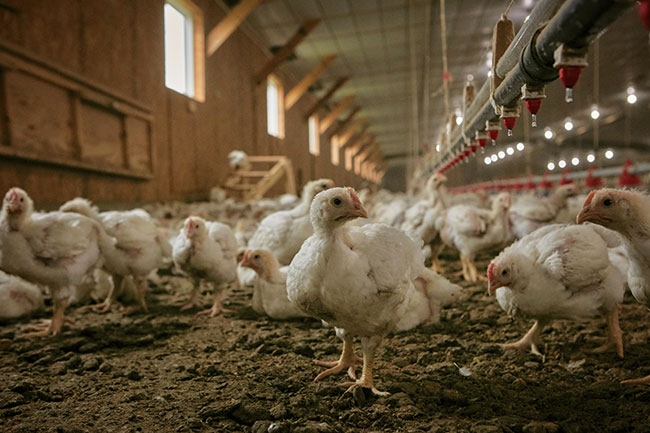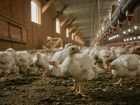
Health Matters: IBD – Poultry’s silent enemy
By Babak Sanei
Features Broilers HealthIt’s one of the most significant immunosuppressive diseases in the Canadian chicken industry.
 Administering the right vaccine at the right age for vaccination is your best bet for success.
Administering the right vaccine at the right age for vaccination is your best bet for success. It’s one of the most significant immunosuppressive diseases in the Canadian chicken industry. Infectious bursal disease (IBD), also known as Gumboro disease, is caused by a very highly contagious and immunosuppressive virus (family Birnaviridae) in chickens.
The virus is hardy and survives in the poultry house for a long period, and common dry-cleaning practices (without complete washing and disinfection between crops) does not eliminate the virus and can affect the future flock placements. Proper breeder and broiler vaccination are also required for successful control of this costly disease.
There are two distinct types of IBD viruses, serotypes I and II, but only serotype I viruses are pathogenic to chickens. Based on virulence of the virus, IBDV is further divided into: classical strains (with high bursal lesions and mortality of usually less than 20 per cent); very virulent IBD strains (with severe bursal damage and high mortality of greater than 20 per cent); and variant strains (that can potentially cause significant bursal lesions and immunosuppression and secondary infections with low mortality).
In Canada, based on available data, there have been no confirmed diagnosis of very virulent IBD in commercial broilers. However, variants IBD strains are quite common and can result in subclinical form of disease with no apparent clinical signs. With high level of infection, IBD variants can result in significant damage to bursa and result in subsequent immunosuppression.
The importance of proper vaccination and thorough cleaning and disinfection against IBD would become more prominent if other concurrent infections occur such as infectious bronchitis (IB) and virulent reoviruses that are currently present mainly in Ontario and Quebec.
Consequences of infection
If birds are infected with variants strains of IBD, the consequences depend on several factors. These include the age of birds, level of virus load, level of maternal antibodies (MABs) during the first two to three weeks of life, vaccination program and presence of other concurrent diseases.
Infectious bursal disease virus (IBDV) will affect the most important immune organ of young broiler chickens, Bursa of Fabricius. The negative impact on this organ during the life of a broiler flock directly affects the immune status and ability to resist against other pathogens.
If birds are infected at early ages (before two to three weeks), the developing B lymphocytes (main cells of bursa) will be permanently damaged and result in significant immunosuppression. The affected broiler flock is prone to secondary infections that can manifest in different forms such as colibacillosis due to E.coli, lameness (e.g., arthritis and tenosynovitis due to Staphylococcus, enterococcus and/or E.coli infections), higher susceptibility to coccidiosis (e.g. Eimeria tenella breaks) and higher condemnations (e.g., higher cellulitis) and overall poor performance.
In the context of current spread of DMV strain of IB in Ontario and Quebec, control of IBD becomes even more important. That’s because if a bird’s immune system is compromised vaccination against IB would prevent ideal protection. Higher negative impact due to IB and possibly higher condemnation rate can be expected if concurrent infections of IB and IBD occur in the same flock.
On the other hand, if the broiler flock is infected at later stages of grow out (greater than three weeks of age), then it can still result in destruction of B-cells but the immunosuppression is temporary and the severity is milder. Under this scenario, producers may notice a mild increase in condemnations and slight increase in FCR and poor flock performance.
If flocks are very close to shipping then there might be no immediate negative impact on performance. However, the virus can gradually build up in the environment and cause earlier infection in future placements. Therefore, regardless of the observed impact, IBD infections must be addressed with a proper vaccination program, biosecurity and possibly complete cleaning and disinfection to reduce environmental load of the field variant virus.
Vaccines in broiler flocks
Most Canadian breeder flocks are hyperimmunized (multiple live and killed vaccines) against IBD, which provides a good level of MABs to broiler progenies that can protect them at least for the first two weeks of life. Having said that, if the load of IBD infection is very high, IBD variants can potentially break through MABs and affect the bursa at early ages.
Another complicating factor is that usually a single broiler flock is sourced from several breeder flocks that can be at different stages of production and various level of antibodies against IBD. Hence, a broiler flock can have a portion of chicks with low maternal antibodies that are susceptible to IBD infection at early ages.
On the other hand, most commercially available vaccines contain classical strains of virus, which is not fully protective against variants. There are few vaccines that have variant and classic strains but they are also not effective on all different types of variants. Some of these vaccines are mildly antigenic and more prone to be neutralized by MABs.
Depending on the genetic proximity of a given vaccine to a certain variant (that is shown in molecular diagnostic results), it is possible to have acceptable cross protection. In my experience, there is competition between live vaccine strains and field virus in residing and replicating in bursal tissue of chickens.
It is possible, by selecting the right vaccine for a farm (with the history of IBD problem) and applying the vaccine over multiple crops, to gradually reduce the load of field virus and eventually replace the field virus and control the negative impacts of field virus. In some cases, the level of IBD infection is very high and complete cleaning and disinfection is also required.
There are three different types of IBD vaccines currently available for use in broiler flocks:
- Live attenuated vaccines are classified based on their level of antigenicity and ability to survive in the presence of maternal antibodies.
a) Mild vaccines are usually used at the hatcheries and can only provide protection to chicks with low MABs, but will be neutralized in birds with moderate and high MAB. To get better protection usually a second vaccination (intermediate type) is needed during seven to 14 days of life. Your veterinarian can help to determine the best age for booster vaccination.
b) Intermediate vaccines are more immunogenic and less prone to be neutralized by MABs. These vaccines are usually used in the second week of life of broiler flocks. The age of flock when these vaccines are used is important to get the best protection. Your veterinarian is key in determining the best age of vaccination. - Recombinant IBD vaccines are used at the hatchery and via in-ovo vaccination. Their induced immunity provides good protection against mild to moderate level of IBD infections that mainly affects flocks after 10 to 14 days of life.
- Antigen-antibody complex vaccines contain a strong live strain of IBD virus and are ideal to address the problem of persistent high IBD challenges. These vaccines are also used at the hatchery via in-ovo route. The technology of the vaccine enables it to be effective in birds with varying level of maternal antibodies. In cases of persistent high IBD infections, it is better to use these vaccines over multiple crop placements and allow the vaccine to gradually replace the field virus.
Proper diagnosis and monitoring
The first approach is to visually inspect the bursa in five randomly selected broilers around four weeks of life. Your veterinarian would be your best resource to assess the bursa and determine if the size is appropriate for age. Samples can be sent for histology, if needed.
If you have recurrent historical elevated condemnation rates, take blood samples at the processing plant (if possible) or at the farm close to shipping and run Elisa serology for IBD. Ten to 15 blood samples per given broiler barn is sufficient. Very high titers against IBD can suggest possible IBD infections.
Based on my experience, available live IBD vaccines in Canada usually don’t result in high titers (range of negligible to about 2,500 Geometric Mean (GM) titers depending on the type of vaccine and age of vaccination) around 35 days of age when most flocks are shipped, while high infection with field virus (especially at early ages) can result in higher titers.
The level of antibodies mainly depends on when blood samples are taken post IBD infection. One word of caution is that low GM Elisa titers doesn’t necessarily mean that it is due to vaccination and not field infection. Further molecular tests are needed to differentiate. If the flock is infected close to shipping (e.g., around seven days prior to shipping), level of antibodies due to field virus can still be low and misleading.
When veterinarians suspect IBD after visually assessing the bursas of five randomly selected birds of around 28 to 30 days, half of the bursas can be submitted in formalin for histology and the other half for PCR or RT-PCR molecular tests.
If the PCR or RT-PCR result is positive and shows high loads of virus in the tissue, it can be sequenced. The result of sequencing is a table that helps producers and their veterinarians to select the best vaccine for type of variant present.
In the end, there is no perfect vaccine that will work on all variant strains. That said, administering the right vaccine at the right age for vaccination is your best bet for success.
Babak Sanei is manager of veterinary services – poultry vaccines and medicated feed additives with Zoetis Inc.
Print this page

